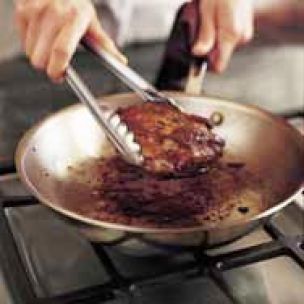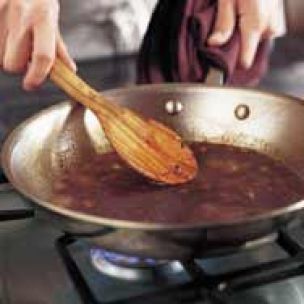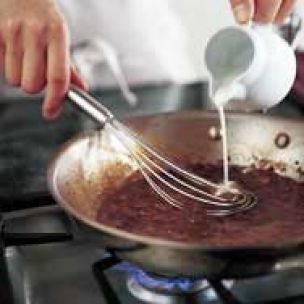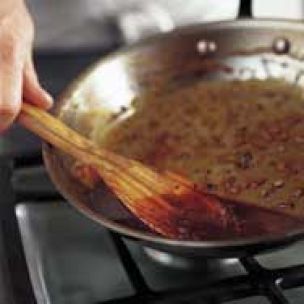Perhaps more than any other cuisine, French cooking is defined by its grand array of sauces. But each sauce is not unique from start to finish; instead, almost all French sauces are developed out of a handful of so-called mother sauces. Once you understand how the components of these basic sauces come together, you will be able to master a wide variety of different sauces, and then maybe even invent some of your own.
Vinaigrettes
A vinaigrette is perhaps the simplest of French sauces, and there is no mystery to making a good one. First, make sure to use a bowl big enough to allow you to whisk vigorously. Start with good-quality vinegar or citrus juice, then add seasonings such as minced herbs. Slowly drizzle in the oil—extra-virgin olive oil and buttery hazelnut and walnut oils are all good choices—whisking constantly until the mixture emulsifies, becoming semiopaque and thickened. Adding a small amount of finely minced shallot or a teaspoon of mustard to the vinegar will help the dressing to thicken. Finally, season with salt and pepper. It's best to whisk your vinaigrette again just before using; most dressings separate upon standing.
White Sauces
Creamy, elegant white sauces are one of the hallmarks of French cooking. They often begin with a roux, a mixture of butter and flour. The roux is cooked over medium heat for 2 to 3 minutes, just long enough to eliminate its raw taste. The mixture must not be allowed to brown. When milk is added to a roux, it becomes béchamel sauce, which is the basis for most savory soufflés, such as a cheese soufflé. The sauce is simmered on low heat for a few minutes until thickened and smooth. If the sauce doesn't thicken right away, let it cook for a few more minutes, stirring constantly with a whisk. Velouté sauce is made the same way as béchamel, but a light chicken or fish stock is substituted for the milk.
Sweet Sauces
Sweet sauces represent another category of French sauces. They include egg-based custard sauces, such as the one used to make crème brûlée. This mixture of eggs and cream is cooked just until the proteins in the ingredients thicken to form a soft, smooth, satiny dish. To prevent the eggs in the custard sauce from curdling, never add hot liquid all at once to beaten eggs. Instead, "temper" the eggs by slowly whisking in the warm cream or milk. By adding the liquid gradually, you will raise the temperature of the eggs, and the rest of the liquid can be safely added. Baked custards should always be cooked in a water bath (also known as a bain marie) to keep them moist. For the silkiest custard, strain the mixture through a sieve before baking.
Pan Sauces
Pan sauces are another common French sauce preparation. The richly caramelized bits clinging to the pan after a steak is pan-seared or a chicken breast is sautéed are quickly loosened with wine or stock in a step known as deglazing. Then, over medium-high or high heat, the alcohol evaporates and the liquid reduces and thickens. Mustard, herbs or other flavorings may be added and, at the last minute, a bit of butter or cheese may be swirled in, adding a silky finish to the completed sauce. The basic steps are shown here:
-
 1. Browning the food. Sear or sauté the meat, chicken or fish—here a filet mignon—until nicely browned on both sides, then remove the food from the pan.
1. Browning the food. Sear or sauté the meat, chicken or fish—here a filet mignon—until nicely browned on both sides, then remove the food from the pan.
-
 2. Deglazing the pan. Add liquid—here port—and bring to a boil over high heat, stirring with a wooden spoon to dislodge any browned bits stuck to the pan bottom.
2. Deglazing the pan. Add liquid—here port—and bring to a boil over high heat, stirring with a wooden spoon to dislodge any browned bits stuck to the pan bottom.
-
 3. Reducing the sauce. Continue to boil until the sauce is reduced as directed—here to 1⁄3 cup—then whisk in any additions, such as crème fraîche or cream (shown here).
3. Reducing the sauce. Continue to boil until the sauce is reduced as directed—here to 1⁄3 cup—then whisk in any additions, such as crème fraîche or cream (shown here).
-
 4. Finishing the sauce. If the recipe calls for reducing further, continue to boil as directed, in this case until reduced by half. Whisk in any final ingredients—such as crumbled cheese—and cook until smooth and thickened.
4. Finishing the sauce. If the recipe calls for reducing further, continue to boil as directed, in this case until reduced by half. Whisk in any final ingredients—such as crumbled cheese—and cook until smooth and thickened.











